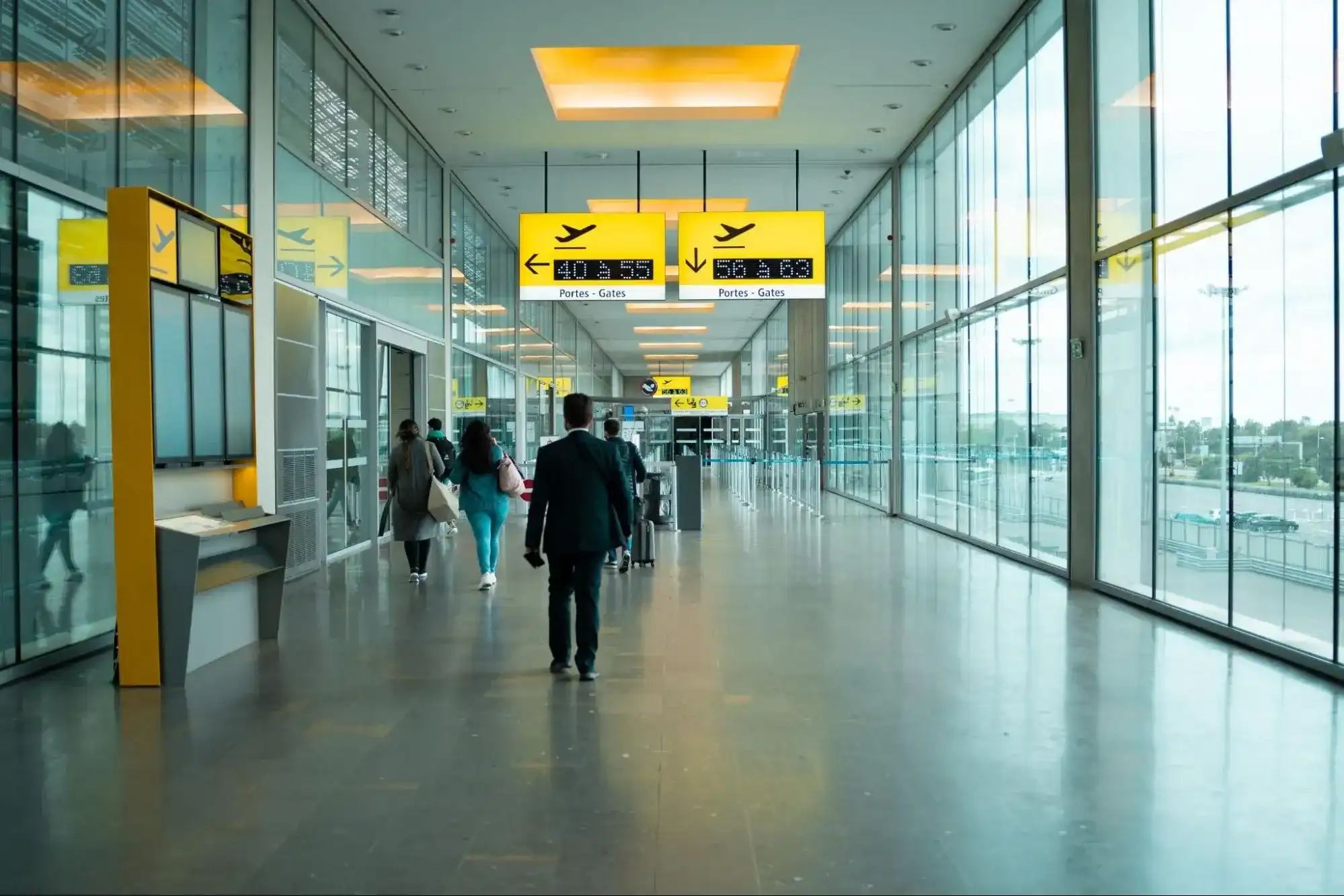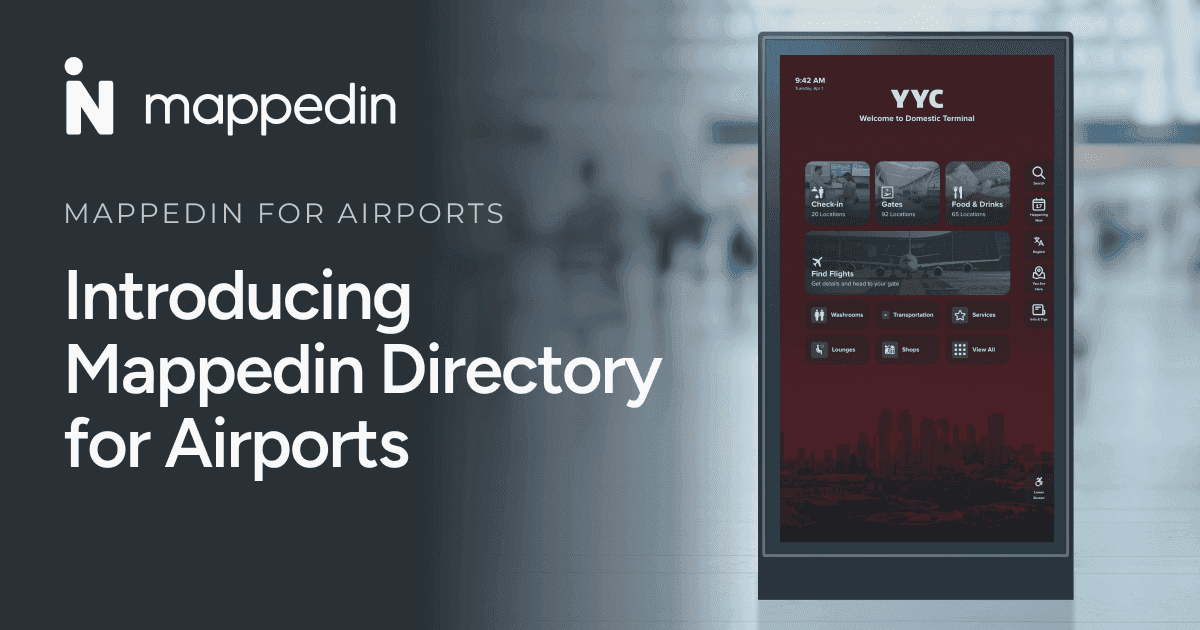With large amounts of passengers travelling through an airport on any given day, there is great potential for improving the airport experience with location-based marketing. Eliminate travel stress, encourage passenger spending, and provide exceptional service with indoor navigation technology.
What is location-based marketing?
Location-based marketing (or proximity marketing) is a tactic that utilizes a person’s physical location to target them with personalized messages. Using past and real-time location data, marketing teams can reach consumers based on qualifiers such as proximity to retail stores, events happening within their area, and more. A common location-based marketing strategy is to send real-time mobile notifications to visitors through a mobile app or mobile service when they are within a certain distance of a store.
How does location-based marketing work for airports?
Like shopping malls and campuses, airports can use location services and indoor positioning technology to target visitors based on their current location. There are several technologies available, including beacons, wi-fi, RFID, and geomagnetic, to understand this real-time position as people navigate through an airport. In order to execute a functional and successful location-based marketing strategy, you must have an understanding of a user’s current location through positioning layered with a digital airport map, and users must opt-in to receive notifications.

Advantages of location-based marketing for airports
Along with its unique targeting ability and the opportunity for impact throughout the buyer journey, location-based marketing has several other advantages for airports. It enhances functions such as wayfinding, flight information, loyalty programs, and acts as an additional channel to increase non-aeronautical revenue streams. Driving relevant and timely location-based campaigns enables airports to increase mobile user engagement and create personalized passenger experiences.
Engaging airport visitors in real-time
As travellers frequently turn to their mobile devices for immediate answers, it is critical that airport marketers leverage mobile (through airport apps or mobile services) to address the key concerns of their target audience. How far is the boarding gate? Is there a restaurant nearby? What are the security wait times? The main challenge lies in timing. How can airports ensure the right message gets delivered at the right stage in the passenger journey? By targeting users in real-time with location-based advertising. If someone is within 20m of a duty-free store for example, you can send them a 10% off coupon code to encourage spending.

Understanding the passenger behaviour
Indoor location-based technology combined with real-time analytics helps airports better understand and predict passenger behaviour. In turn, marketers can send highly relevant and personalized messages, providing passengers with better ways to find and enjoy the services at the airport. Passengers can avoid filtering through content that does not appeal to them, and receive well-timed notifications that align with their interests. For example, if a passenger previously bought from a retail outlet in the airport, they can be advised of an exclusive promotion the next time they pass by the store.
Customer experience: less stress means more spending
Stress can have a negative impact on the passenger experience and can greatly discourage passengers from making the most of the services and retail offerings available to them. However, location technology presents opportunities for marketers to update passengers along their route and notify them of boarding times. Knowing there's thirty minutes to spare, they are more likely to browse duty-free shops or grab a quick bite to eat before their flight. Research also indicates that being relaxed has a positive impact on customer spending, meaning relaxed passengers are likely to spend more.

What does an effective location-based marketing campaign look like?
There are several ways airports can launch a location-based marketing campaign. Let’s explore some examples:
- Keep up with passengers. Passengers are constantly moving and catching them at the right moment is challenging. Location-based marketing can be used to connect with travellers who want to receive real-time push notifications, alerts, and emails.
- Hyperlocal marketing. When your target audience enters a very limited geographic area, such as an airport checkpoint or parking lot, trigger messages that are extremely relevant. Consumers greatly appreciate extremely relevant messages and special discounts.
- Utilize smart spaces. Beacons, wi-fi, and other indoor positioning technology platforms allow retailers and individuals to engage through interconnected networks. Being able to push relevant ads or offers for products while a customer is in-store is becoming more commonplace.
Using location-based marketing successfully for airports
Airports can successfully leverage location-based technology to provide an array of digital services to passengers. Seamless indoor navigation to airport checkpoints, location specific information in real-time, personalized deals and promotions, and more. Here are some additional ways to deliver an end-to-end passenger experience with this strategy:
- When a passenger enters the airport, immediately trigger an update on the status of their flight
- Once a passenger has arrived at their destination, send a push notification of their baggage carousel number
- Target users with relevant offers on retail and dining based on prior purchases and points of interest
Targeting customers based on timing and Location
Location-based marketing improves the passenger experience by providing personalized updates, directions, and tips based on real-time locations and interests. When passengers are passing by specific airport checkpoints, such as the check-in counter, trigger a notification of the security wait times. Provide updates of how long it will take to walk from security to the boarding gate, and convey relevant retail deals and promotions along the route.

How to choose the best location-based marketing system for airports
There are many proximity marketing platforms to choose from. Airports must find a product that:
- Identifies a target audience (or potential customers) within specified geographic boundaries through the use of geofencing, wi-fi, beacons, or a similar geotargeting technology
- Provides a platform that includes communication tools to deliver scheduled, targeted, and automated messages based on their location
- Provides analytics or a dashboard to analyze proximity-based marketing campaign metrics and performance
- Allows customers to opt-in and out of marketing communications and updates distribution lists automatically for the Marketing team
What sets MappedIn apart?
Mappedin provides digital, interactive maps that make navigation simple for passengers. With an indoor mapping platform on-hand, travellers can enjoy seamless outdoor-indoor navigation and combined with precise location data, airports can better understand foot traffic, how people move through the space, as well as where and how to target them.

The most fundamental element of location-based marketing is location data. Without this, airports can not accurately target their potential customers. A digital map allows you to visualize where people are in relation to your target area. The airport map is a foundational layer to enable heightened visual and location-based experiences.
Location-based marketing for airports FAQs
What is proximity marketing?
Proximity marketing is also known as location-based marketing. There are three key components required to build a proximity marketing experience: the advertising content, positioning, and the digital map. Mappedin’s blue dot navigation feature takes care of the second piece for marketers hoping to target airport passengers.
How does location-based push notifications & geofencing work?
Geofencing refers to drawing an area around a location, or locations, where an audience visits in order to serve them real-time ads and content. When a prospective or existing customer is within a predefined proximity (or geofence), a location-based push notification is triggered to their mobile device.
How to start engaging mobile users with location-based marketing?
By tapping into indoor location-based technologies, airports can start engaging with their target audience through mobile services. Many marketing leaders often find it challenging to leverage the right location-based marketing strategies. It is important to focus on a solution that:
- Increases passenger experience
- Stays relevant to your passengers and is scalable over time
- Uses communication channels effectively, whether it is through social media, email, or mobile notifications
- Has mass appeal but can still focus on segments important to the retailers and services in your airport
Visit our Airports industry page or contact us to get started.
Tagged In
Share



